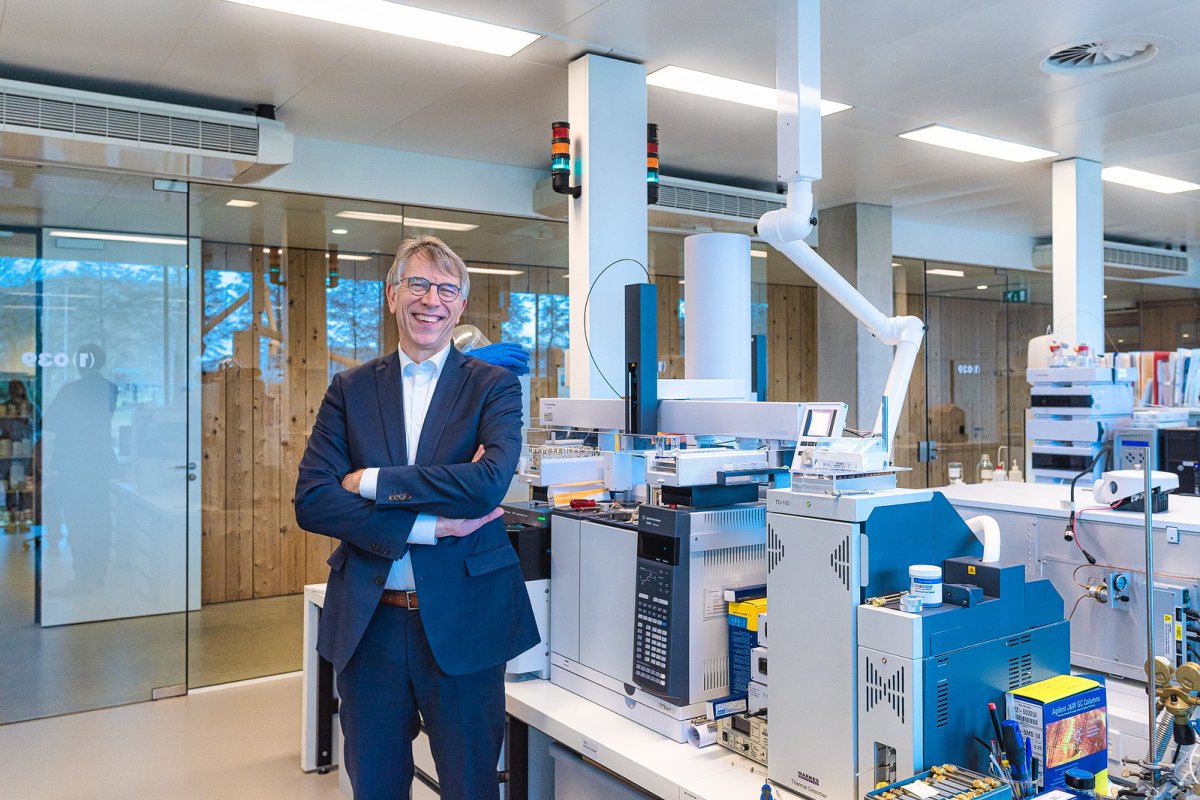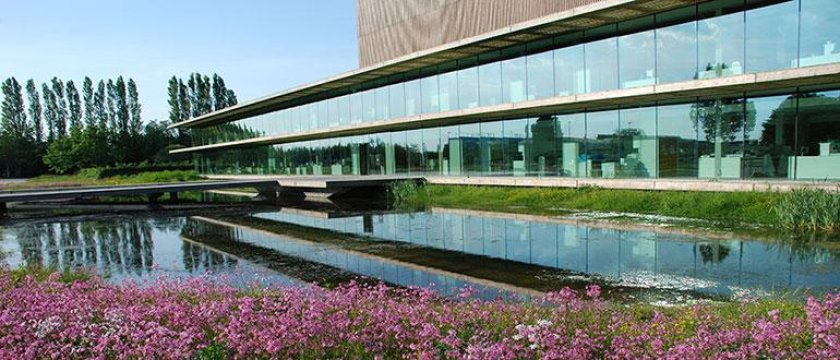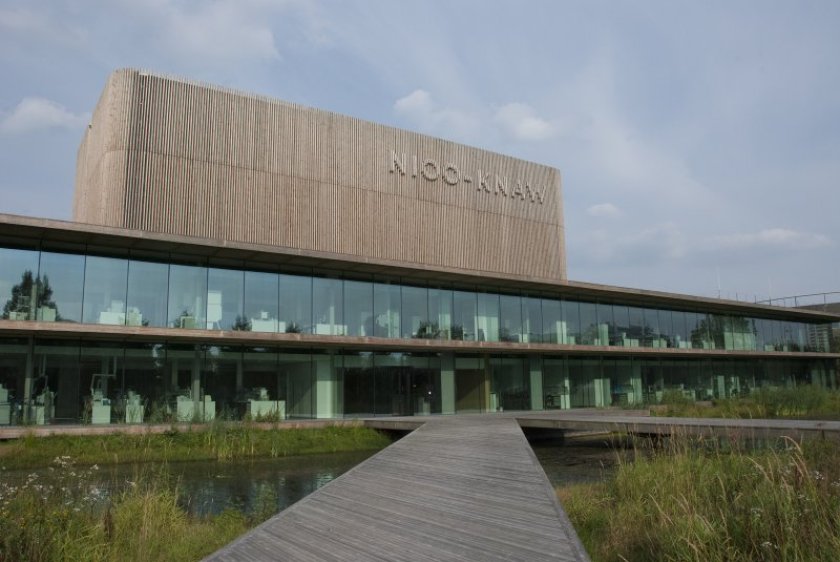
News
NIOO’s Geert de Snoo: “Proximity helps in collaborating”
When cruising down over the Mansholtlaan from the A12, you can not help but notice an eye-catching, wood-panelled building with rounded corners east of the Mansholtlaan. The structure, built according to the cradle-to-cradle principle, houses the Netherlands Institute of Ecology (NIOO-KNAW). With Aeres college, NIOO is very much part of Wageningen Campus. An interview with director Geert de Snoo, who sees plenty of possibilities to collaborate on urgent issues with campus inhabitants.
"What is better than collaborating if you are good at something?"
Geert de Snoo is a relatively new face on campus. He took the position of director of NIOO in November 2019. For the last seven years, he was dean at the Maths and Natural Sciences faculty and professor of Conservation Biology in Leiden. The latter position is one he still holds. “As a dean, I was much like a managing director, responsible for all beta courses offered by the faculty; from astronomy to, and including, the botanical garden. Extremely interesting, and a job that I really enjoyed. But my roots are in ecology. This job at NIOO offered me a perfect opportunity to return to my primary area of expertise, and to collaborate with others who share my passion. And my managing role allows me to invest in ecology as well as in safeguarding and expanding our national position as an ecological institute.”
Public function
NIOO is one of four national KNAW (Royal Netherlands Academy of Sciences) life science institutes, and the only institute that focusses on ecology. De Snoo considers it NIOO’s task to perform excellent research, facilitate national ecological research, and to make research results available to the general public: “Not just to fellow researchers, but the broad public. We have open days, for example, but also soil-dweller days. We help people recognise soil and water creatures they may find in their back yard or nearby ditch. We publish special booklets and search maps about these ‘public creatures’. This way, we are fed with information on viewings, which is helpful to us. Citizen science, as it were. This allows us to propagate our research actively.”

Furthermore, there are weekly guided tours through the facility to provide insight into the work of ecologists, but also to show the NIOO-building itself is a research object. “Visitors can see how we keep our water clean and what scientific knowledge is required to do so. For example, we filter nutrients from our water using algae and reeds.”
The more people collaborate on crucial issues, the better
NIOO researchers study climate, biodiversity and nature, including agriculture. From a scientific perspective, it is interesting and relevant to identify the scientific mechanisms driving these themes, says De Snoo, but also to apply the insights from the field of ecology for innovations. Consider, for example, efficiently recording carbon in soils and combatting methane emissions. But also: restoring nature and farming land through soil transplants or the introduction of soil organisms.
The fact that various groups within neighbouring Wageningen University & Research (WUR) are active in the same field is not a problem, according to Geert. He was linked to WUR for several years as endowed professor of Nature Conservation and Plant Ecology. Furthermore, several WUR groups and NIOO are joined together in the Centre for Soil Ecology. “My position is: the more people collaborate on crucial issues, the better. Both NIOO and WUR researchers are doing excellent research. And what is better than to collaborate if you are good at something? If WUR finds solutions to these issues, that’s perfectly fine. We are continuously looking for groups/partners.”
"My position is: the more people collaborate on crucial issues, the better."
Rapid evolution
“I do see differences: NIOO is a public organisation, and, as such, non-commercial by definition. We do not have spin-offs, that is not our core business. We don’t optimise a single crop, but we attempt to develop more general principles, that can then be used in applied research. We also do (very) long term research. In the case of tits, as long as 65 years. This helps us to see how nature reacts to change and provides us with insights on the (rapid) evolution of species.”
You must meet each other
NIOO is part of Wageningen Campus. A sentiment felt by the NIOO employees, according to De Snoo. In the past, NIOO had three locations. In 2011 the institute chose to settle in Wageningen, bringing together all sweetwater and soil ecologists in a unique building. He does, however, refer to ‘the other side’ of campus. The Mansholtlaan is apparently a barrier of sorts.
- Unfortunately, your cookie settings do not allow videos to be displayed. - check your settings
Check out the video on the (cradle-to-cradle) NIOO building
Born in the vicinity of Amsterdam, he remains a city-dweller, commuting to Wageningen by bus and train from Leiden, where he has lived for the past 25 years.
He finds it challenging to compare Wageningen Campus to the Leiden BioScience Park because he is not yet able to judge how much collaboration there is. “In Leiden, I was part of the park’s think tank, and I know there is collaboration on research issues. There, directors of the different companies, research institutes and local government would regularly meet, over dinner, for example. You must meet each other. I consider Barcelona very inspiring. There, you have composite buildings with university departments on one side of the corridor and start-ups on the other.
Proximity helps in collaborating. So, I certainly see the value of being part op Wageningen Campus. I felt very welcome during my introduction. Our networks are not limited to Wageningen though. NIOO is a national institute. We organise a weekly seminar, which is attended by students from Wageningen and Groningen alike.”
Our facilities are widely available
Personally, De Snoo is not actively involved in sharing facilities on Wageningen Campus (through Shared Research Facilities – Ed.). But he knows NIOO, and WUR researchers actively use each others’ facilities and equipment. “NIOO has approximately 12 professors, seven of which hold a chair in Wageningen. Using each others equipment, and carrying out experiments together, has obvious advantages. We have WUR PhD candidates working for us, so there certainly is an exchange of knowledge and facilities. For example, we have large (1000 litre) tanks available to research plastics in the water. That is a valuable research infrastructure we are eager to share. The issues our domain faces are huge and urgent. This means we must join forces.”

Axis in the ecology web
When asked if NIOO wants to further develop its contacts with other companies on Wageningen Campus, De Snoo responds with enthusiasm. Aside from ecology, NIOO is looking for partners in the domain of Artificial Intelligence (AI), sensor technology and image analysis.
“Biology is a complex domain with many interactions and variables. To understand anything, we need models, statistics, maths, AI and sensor technology. There is so much going on in our field; we are faced with enormous challenges. That is why we are eager to collaborate and share with different companies and link up with the region and nation.”
NIOO also has much to offer Wageningen Campus. “Having a national institute on campus benefits WUR. We are at the very heart of the ecology web. We have a national birding station where we have been performing research since 1911. This bounty of data allows us to follow the spread of diseases. This research may be expanded with other partners. Studying complex ecological issues together is my dream. Wageningen offers wonderful opportunities.”
